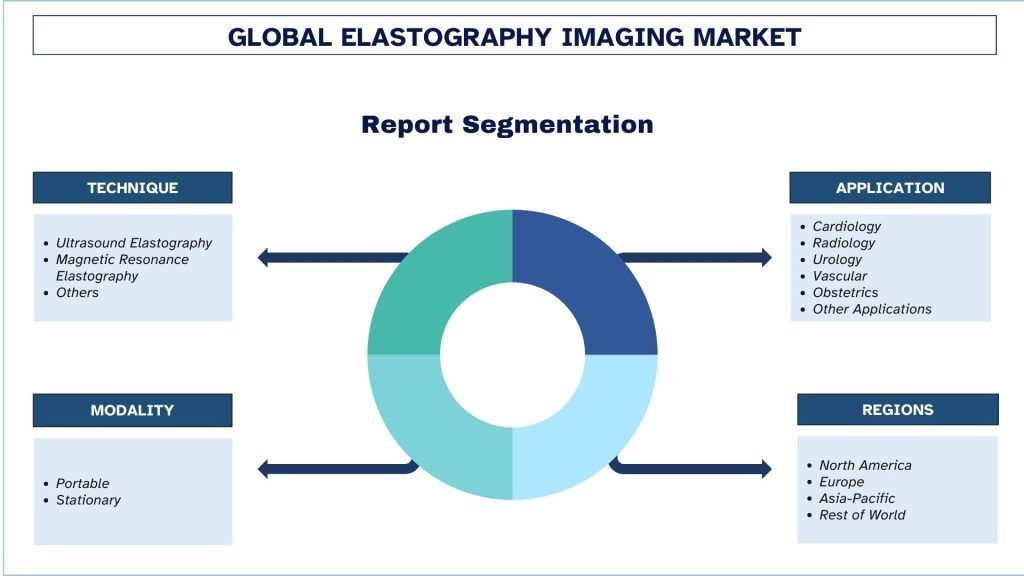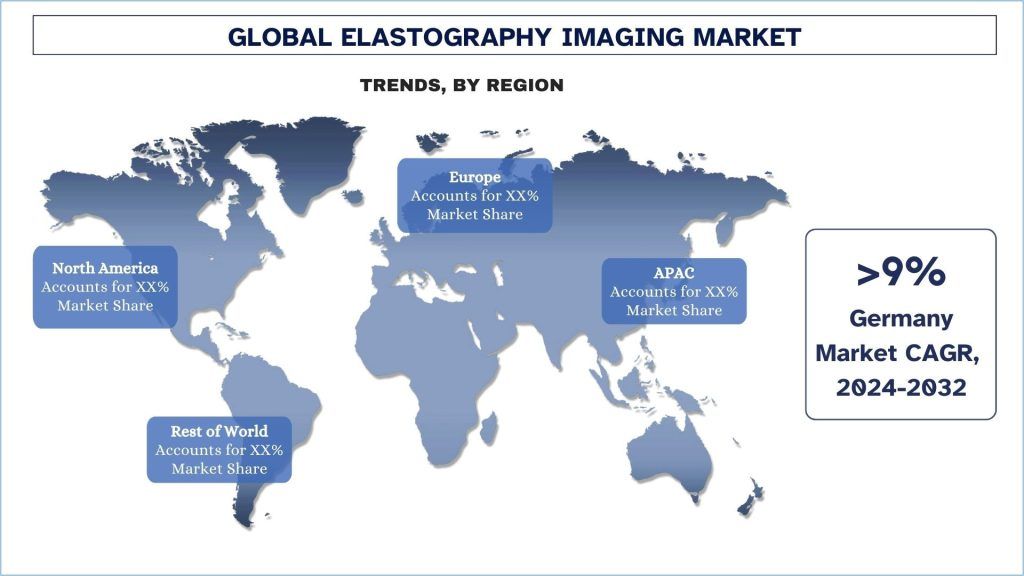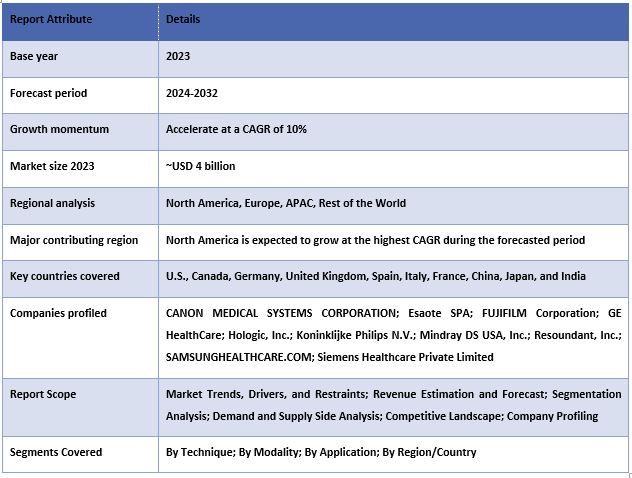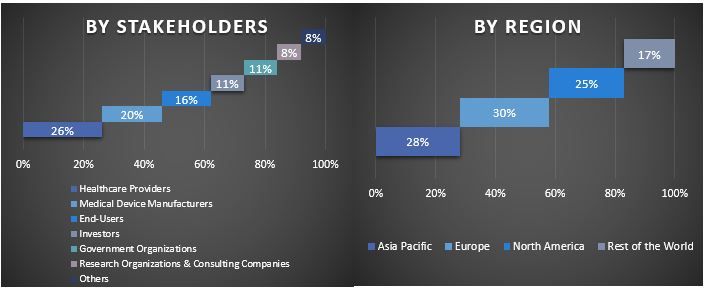- Home
- About Us
- Industry
- Services
- Reading
- Contact Us
Elastography Imaging Market: Current Analysis and Forecast (2024-2032)
Emphasis on Technique (Ultrasound Elastography, Magnetic Resonance Elastography, and Others); Modality (Portable and Stationary); Application (Cardiology, Radiology, Urology, Vascular, Obstetrics, and Others); and Region/Country
Elastography Imaging Market Size & Forecast
The Elastography Imaging Market was valued at approximately ~USD 4 billion in 2023 and is expected to grow at a strong CAGR of around 10% during the forecast period (2024-2032) owing to the increased number of chronic disease cases globally.
Elastography Imaging Market Analysis
Elastography imaging is part of the diagnostic imaging industry which is rapidly evolving in the healthcare market by using a high-frequency vibration to analyze tissue stiffness to diagnose and stage diseases like liver fibrosis, tumors, and musculoskeletal disorders. Artificial intelligence’s integration and optimization of software contribute to the advancements of elastography in terms of precision and speed. The market is growing owing to the increasing healthcare infrastructure in developing nations and the emphasis on the individualized approach to diseases. Company collaborations, acquisitions, and innovative product launches also drive the industry’s growth.
In February 2024, Echosens introduced its new guided vibration-controlled transient elastography (VCTE) technology, available on new FibroScan systems. Guided VCTE uses Echosens’ diagnostic expertise to provide liver stiffness measurements, a critical fibrosis marker. The company highlighted that the tool takes four minutes for a full scan and uses two visual indicators – one for liver stiffness and one for controlled attenuation parameter – to aid the operator in quickly identifying the optimal measurement location.
In May 2022, FUJIFILM VisualSonics Inc. announced the launch of Vevo F2, the world’s first ultra-high to low frequency (71MHz-1MHz) ultrasound and photoacoustic imaging system for preclinical use. The Vevo F2 features HD image processing technology and introduces a completely new signal pathway – from transducer to display screen. This enables better image clarity, and when combined with multi-line processing, delivers significantly improved frame rates over earlier-generation platforms.
Elastography Imaging Market Trends
This section discusses the key market trends that are influencing the various segments of the elastography imaging market, as identified by our team of research experts.
Magnetic Resonance Elastography Segment Transforming Industry
Magnetic resonance elastography (MRE) is one of the segments of the elastography imaging market that is growing rapidly due to its enhanced capacity to deliver a highly resolved picture of the stiffness of tissues. MRE’s non-invasive modality and high spatial resolution make MRE primarily suitable for diagnosing and staging pathologies, such as liver fibrosis, tumors, and brain lesions where accurate measurement of the tissue elasticity is essential. Its growth is supported by the development of new technologies helping to improve imaging quality and accelerate the process, as well as by the growing use of the segment’s offerings in clinical practice due to the demand for better diagnostic means. Furthermore, the increase in incidence rates of chronic liver diseases and the realization of the need for early and targeted disease diagnosis through ME in the elastography market contributes to the sustained growth of MRE.

North America is expected to grow at a significant rate in the forecast period.
The North American elastography imaging market is rapidly growing due to technological enhancement, the increasing rate of chronic diseases, and the growing utilization of non-invasive diagnostic procedures. The region experiences a well-developed healthcare system, high investments in medical research and technologies, and is home to many of the leading healthcare device manufacturers. Updated features in elastography like real-time imaging and integration of the tools into artificial intelligence improvements enable better diagnosis and permit the use of the tool in many subspecialties. Also, the rise of personalized medicines and the increase in healthcare spending added to the market growth even more. Consequently, North America provides a conducive environment for the further advancement and exploitation of the latest elastography imaging systems.
According to the American Cancer Society’s estimates for primary liver cancer and intrahepatic bile duct cancer in the United States for 2024, about 41,630 new cases (28,000 in men and 13,630 in women) will be diagnosed with cancer and about 29,840 people (19,120 men and 10,720 women) will die of these cancers.
According to the National Cancer Institute, in 2021, an estimated 3,972,256 women were living with female breast cancer in the United States.

Elastography Imaging Industry Overview
The elastography imaging market is competitive, with several global and international market players. The key players are adopting different growth strategies to enhance their market presence, such as partnerships, agreements, collaborations, geographical expansions, and mergers and acquisitions. Some of the major players operating in the market are CANON MEDICAL SYSTEMS CORPORATION; Esaote SPA; FUJIFILM Corporation; GE HealthCare; Hologic, Inc.; Koninklijke Philips N.V.; Mindray DS USA, Inc.; Resoundant, Inc.; SAMSUNGHEALTHCARE.COM; Siemens Healthcare Private Limited.
Elastography Imaging Market News
In June 2023, China-based Mindray launched the Hepatus 6 Diagnostic Ultrasound System, which combines transient elastography and diagnostic ultrasound in one device, making it ideally suited for non-invasive detection, diagnosis, and evaluation of liver disease.
In November 2021, Canon Medical Systems Corporation and Resoundant, Inc. signed a licensing agreement to incorporate the advanced Magnetic Resonance Elastography (MRE), developed by Resoundant on the Canon MRI platforms.
Elastography Imaging Market Report Coverage

Reasons to buy this report:
- The study includes market sizing and forecasting analysis validated by authenticated key industry experts.
- The report presents a quick review of overall industry performance at one glance.
- The report covers an in-depth analysis of prominent industry peers with a primary focus on key business financials, product portfolios, expansion strategies, and recent developments.
- Detailed examination of drivers, restraints, key trends, and opportunities prevailing in the industry.
- The study comprehensively covers the market across different segments.
- Deep dive regional level analysis of the industry.
Customization Options:
The global elastography imaging market can further be customized as per the requirement or any other market segment. Besides this, UMI understands that you may have your own business needs, hence feel free to connect with us to get a report that completely suits your requirements.
Table of Content
Research Methodology for the Elastography Imaging Market Analysis (2024-2032)
Analyzing the historical market, estimating the current market, and forecasting the future market of the global elastography imaging market were the three major steps undertaken to create and analyze the adoption of elastography imaging in major regions globally. Exhaustive secondary research was conducted to collect the historical market numbers and estimate the current market size. Secondly, to validate these insights, numerous findings and assumptions were taken into consideration. Moreover, exhaustive primary interviews were also conducted, with industry experts across the value chain of the global elastography imaging market. Post assumption and validation of market numbers through primary interviews, we employed a top-down/bottom-up approach to forecasting the complete market size. Thereafter, market breakdown and data triangulation methods were adopted to estimate and analyze the market size of segments and sub-segments of the industry pertains to. Detailed methodology is explained below:
Analysis of Historical Market Size
Step 1: In-Depth Study of Secondary Sources:
A detailed secondary study was conducted to obtain the historical market size of the elastography imaging market through company internal sources such as annual reports & financial statements, performance presentations, press releases, etc., and external sources including journals, news & articles, government publications, competitor publications, sector reports, third-party database, and other credible publications.
Step 2: Market Segmentation:
After obtaining the historical market size of the elastography imaging market, we conducted a detailed secondary analysis to gather historical market insights and share for different segments & sub-segments for major regions. Major segments are included in the report, such as technique, modality, application, and regions. Further country-level analyses were conducted to evaluate the overall adoption of testing models in that region.
Step 3: Factor Analysis:
After acquiring the historical market size of different segments and sub-segments, we conducted a detailed factor analysis to estimate the current market size of the elastography imaging market. Further, we conducted factor analysis using dependent and independent variables such as technique, modality, application, and regions of the elastography imaging market. A thorough analysis was conducted for demand and supply-side scenarios considering top partnerships, mergers and acquisitions, business expansion, and product launches in the elastography imaging market sector across the globe.
Current Market Size Estimate & Forecast
Current Market Sizing: Based on actionable insights from the above 3 steps, we arrived at the current market size, key players in the global elastography imaging market, and market shares of the segments. All the required percentage shares split and market breakdowns were determined using the above-mentioned secondary approach and were verified through primary interviews.
Estimation & Forecasting: For market estimation and forecast, weights were assigned to different factors including drivers & trends, restraints, and opportunities available for the stakeholders. After analyzing these factors, relevant forecasting techniques i.e., the top-down/bottom-up approach were applied to arrive at the market forecast for 2032 for different segments and sub-segments across the major markets globally. The research methodology adopted to estimate the market size encompasses:
- The industry’s market size, in terms of revenue (USD) and the adoption rate of the elastography imaging market across the major markets domestically.
- All percentage shares, splits, and breakdowns of market segments and sub-segments.
- Key players in the global elastography imaging market in terms of products offered. Also, the growth strategies adopted by these players to compete in the fast-growing market.
Market Size and Share Validation
Primary Research: In-depth interviews were conducted with the Key Opinion Leaders (KOLs) including Top Level Executives (CXO/VPs, Sales Head, Marketing Head, Operational Head, Regional Head, Country Head, etc.) across major regions. Primary research findings were then summarized, and statistical analysis was performed to prove the stated hypothesis. Inputs from primary research were conso0lidated with secondary findings, hence turning information into actionable insights.
Split of Primary Participants in Different Regions

Market Engineering
The data triangulation technique was employed to complete the overall market estimation and to arrive at precise statistical numbers for each segment and sub-segment of the global elastography imaging market. Data was split into several segments and sub-segments after studying various parameters and trends in the areas of the technique, modality, application, and regions in the global elastography imaging market.
The main objective of the Global Elastography Imaging Market Study
The current & future market trends of the global elastography imaging market were pinpointed in the study. Investors can gain strategic insights to base their discretion for investments on the qualitative and quantitative analysis performed in the study. Current and future market trends determined the overall attractiveness of the market at a regional level, providing a platform for the industrial participant to exploit the untapped market to benefit from a first-mover advantage. Other quantitative goals of the studies include:
- Analyze the current and forecast market size of the elastography imaging market in terms of value (USD). Also, analyze the current and forecast market size of different segments and sub-segments.
- Segments in the study include areas of the technique, modality, application, and regions.
- Define and analyze the regulatory framework for the elastography imaging
- Analyze the value chain involved with the presence of various intermediaries, along with analyzing customer and competitor behaviors of the industry.
- Analyze the current and forecast market size of the elastography imaging market for the major region.
- Major countries of regions studied in the report include Asia Pacific, Europe, North America, and the Rest of the World
- Company profiles of the elastography imaging market and the growth strategies adopted by the market players to sustain in the fast-growing market.
- Deep dive regional level analysis of the industry.
Frequently Asked Questions FAQs
Q1: What is the elastography imaging market's current market size and growth potential?
Q2: What are the driving factors for the growth of the elastography imaging market?
Q3: Which segment has the largest share of the elastography imaging market by technique?
Q4: What are the emerging technologies and trends in the elastography imaging market?
Q5: Which region will dominate the elastography imaging market?
Related Reports
Customers who bought this item also bought











